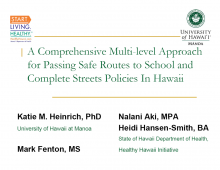We are pleased to announce an exciting new alliance between Active Living Research and GP RED to co-host and coordinate...
A Comprehensive Multi-Level Approach for Passing Safe Routes to School and Complete Streets Policies in Hawaii

Presentation at the 2010 Active Living Research Annual Conference
Background:
Walking and bicycling positively impact childhood physical activity and obesity. However, safety concerns prevail; Hawaii is ranked first in pedestrian and third in bicycle fatalities. Many streets lack sidewalks, adequate crosswalks and bicycle lanes. Accordingly 70% of Hawaii school- children get inadequate physical activity and 30% are overweight / obese. The 2007 Hawaii Physical Activity and Nutrition (PAN) Plan recommends increasing walking and bicycling to school; physical activity and transportation safety have improved after adoption of Safe Routes to School (SRTS) programs and complete streets (CS) policies in other states. These policy solutions would promote health and safety and reform transportation infrastructure to accommodate all users.
Objectives:
Our objective is to describe the various layers of education, capacity building and networking necessary for the passage of statewide SRTS and CS policies in Hawaii.
Methods:
Statewide public health promotion efforts are led by the Healthy Hawaii Initiative (HHI) at the Department of Health (DOH). To effect policy change, HHI used a multi-level approach focusing at the institutional, community and public policy levels of the social ecological model. HHI aimed to educate individuals at each level to build capacity for change.
HHI contracted a national expert to help provide a comprehensive statewide Active Living Community training program. Workshop and educational session topics included active living communities, public health’s role, economic impacts, land use, fostering collaborations and information sharing.
At the institutional level, a September 2007 workshop “Earning Healthier Profits with Healthy Designs,” targeting planners and developers, focused on public health impacts of community design. An October 2007 PAN Summit gathered >300 representatives from businesses, schools and community agencies to showcase PAN best practices and introduce active living concepts. A July 2008 survey of planners/developers queried current issues and challenges; with results disseminated statewide. An October 2008 PAN Forum focused on “Good Health: Creating Active Living Communities.” This smaller meeting reconvened Summit participants and provided progress updates. PAN Summit and Forum sessions included information on active living communities including “Achieving Complete Streets through Safe Routes to School.”
At the community level, March 2008 “Active Living Community Workshops” engaged and equipped community members for change. Policy workshops were conducted with advocacy groups (those currently engaged in built environment policy issues) in August 2008. Besides skill building and action planning for active living communities, representatives from government and advocacy groups prioritized shared goals, with SRTS and CS arising as key policy issues.
At the public policy level, a March 2008 meeting apprised policy makers (state representatives, state senators, and city council members) of activities being planned in their communities. HHI asked for their help and support and invited them to community workshops. Throughout 2008, individual educational meetings were held with departments of permitting and planning representatives, county council members and county commissioners about built environment impacts on physical activity and health. A key supporter of HHI efforts was the Lt. Governor who participated in our related social marketing campaign for walking and was a speaker at the “Earning Healthier Profits with Healthy Designs” workshop, the PAN Summit, and the PAN forum.
Combining efforts at the community and public policy levels, an “Achieving Complete Streets through Safe Routes to School” planning session was held in October 2008. Community advocates and representatives from State, City, and County agencies gathered to collectively discuss and initiate a plan. In December 2008, “Achieving Complete Streets through Safe Routes to School-Part 2” was held to continue the dialogue and formulate collaborative action steps.
In December 2008, HHI convened Hawaii’s elected officials to brief them on current built environment activities, highlight relevant State and County level policies, and provide national policy examples that could be implemented in Hawaii. Specific examples of policy initiatives included concepts such as CS, SRTS, zoning for active living, and smart growth. Policy-makers were able to utilize HHI’s contracted national expert as a resource for developing legislation in these areas.
Legislation was introduced in January 2009 in the Hawaii House for SRTS (HB983) and Senate for CS (SB718). Advocacy groups closely monitored the bill progress, testified at hearings, and assisted legislators and Department of Transportation representatives in crafting amendments to strengthen the bills.
Results:
In June 2009, both of these bills were signed into law by Hawaii’s Governor; Act 100 SRTS (House Bill No. 983; http://www.capitol.hawaii.gov/session2009/Bills/HB983_CD1_.htm), and Act 54 CS (Senate Bill No. 718; http://www.capitol.hawaii.gov/session2009/bills/SB718_HD1_.htm).
Conclusions:
A comprehensive multi-level approach was influential in the passage of SRTS and CS in Hawaii. HHI plans to track the implementation and evaluation of these policies over time in order to determine their impact on increasing the number of children who are able to safely walk or bicycle to school and subsequent impacts on physical activity and obesity levels.
Support:
Financial support for this project was provided by the State Department of Health through the Tobacco Settlement Special Fund.
STAY UP TO DATE
RECENTLY ADDED TOOLS & RESOURCES
MOVE! A BLOG ABOUT ACTIVE LIVING
The "Active Living Conference" aims to break down research and practice silos and...







